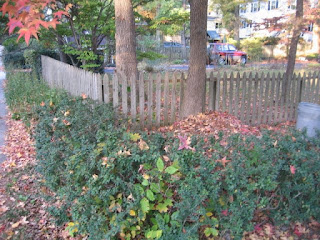This fall, rather than dump leaves in the street or stuff them in bags, consider these options.
Mow them back into the lawn
The easiest option by far is to mow the leaves back into the lawn--an approach recommended by county extension offices around the country, and even by company sites like Scotts Miracle Grow. They've studied it, and concluded that the ground up leaves provide valuable fertilizer for the lawn, and do not cause any problem with thatch.
Some kinds of leaves make this method particularly easy. Pine needles and honey locust leaves are so small they don't even need to be chopped up by a mower, or can be raked underneath shrubs to serve as a mulch. Leaves of silver or red maple also tend to "melt" back into the lawn, decomposing quickly.
Grind leaves up with an electric leaf mower/vac
This will take care of leaves the lawnmower can't reach. Electric leaf blowers are quieter than the gas varieties, and some designs can be reversed to vacuum up leaves and grind them. I have not tried this method, but the NPR show You Bet Your Garden had a segment singing the praises of leaves ground up this way as mulch for flower beds. Even if you buy locally, you can check out reviews of various brands here on Amazon, with prices well under $100.
Make Room(s) For Leaves in the Yard
If you choose to collect leaves into piles rather than grind them, the question becomes where to put them if not on the street. One factor that makes people more likely to blow leaves out to the street is that most yards lack "rooms." The typical yard has shrubs pushed against the house and fenceline, defining only one sprawling "room" that extends uninterrupted to the curb, all of which is then required to be ornamental.
Houses have rooms that separate utility and storage from living areas, so why not yards? If you use shrubs or wooden walls to define and screen small utility areas in the yard, it becomes very easy to store leaves while they decompose and slowly return to the soil from which they came. Nature's miraculous trash-free economy is then allowed to function, and we're spared a big mess in the streets and the considerable municipal cost of hauling, grinding and mechanically turning leaves at a distant composting center.
The photo shows one such configuration in a friend's backyard. The wall provides screening between the utility area with compost pile and tools, and the ornamental garden to the left.
Another way to break up space and screen a leaf pile from more ornamental areas is to plant shrubs out a distance from the fence. The leaves can then be piled inbetween the shrubs and the fence. Though a back corner is the most logical location, the one in the photo is next to the street.
Here's the view from the street. The shrubs are privet, but a native evergreen alternative would be inkberry (Ilex glabra). Other smaller native shrubs--not evergreen but with attractive flowers, would be Itea virginica, Clethra alnifolia or Fothergilla. The main idea is to reconfigure how shrubs of any kind are planted in the yard, so as to create refuges for leaf piles that will quickly be flattened down by the weight of rain and snow and benefit shrubs and trees through the steady process of decomposition. Sectioning off a "room" in the yard also breaks up the monotony of shrubs lining the fenceline and foundation.
Whether ground up or piled in a corner, leaves serve as a natural fertilizer and increase the capacity of the yard to absorb rain. The more organic matter a yard contains, the more moisture it can hold, which helps buffer the yard from extremes of rain and drought. A soil rich in organic matter welcomes the rain, which in turn reduces runoff into the streets and, collectively, the amount of flooding downstream.




4 comments:
How long do leaves typically take to mulch? Ours from last year still look very much like dried out, somewhat squished leaves, not compost.
Depends on the kind of tree, and also on whether the leaves are moist or got piled and compacted in a dry condition. Oak leaves tend to decompose slowly. Maple, ash, and elm leaves much more rapidly. All of this relates to fire ecology, which is too long a story to tell here. Grinding up leaves increases the surface area available for microbes to do their work on, so expedites decomposition. Most piles of leaves, even those not ground up, greatly reduce in size over the year. You may also have compost at the bottom of the pile while the top leaves appear little changed.
You need to add lawn clippings and coffee grounds and other "green" matter to the leaves. If you do this over a winter (mixing from time to time), you'll get mulch the following spring. We do this by capturing our leaves in a cylinder of garden fence, throwing lawn clippings and coffee grounds into the leaves and occasionally stirring them in. Very good mulch at the bottom of the pile within months.
Thanks for those replies!
Post a Comment